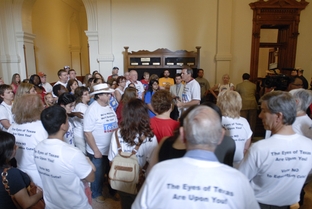And Then There Were Taxes

A week has passed since school districts bracing for the worst at last got what they've been waiting for throughout the legislative session: finality.
With the finance plan doling out the $4 billion reduction in state funding to schools firmly in place, they are now turning to the difficult work of finalizing their own budgets. In most instances, districts have already made cuts to programs and personnel for the upcoming school year, so that means looking at ways to find additional revenue. And that means dipping into fund balances, the school district equivalent of a Rainy Day Fund — or raising local property taxes.
The timeline for tax hike proposals varies by district, depending on when their school boards meet. For many, the announcement will come during their July and August meetings. Most of the state's biggest districts have refused to rule out the possibility of tax increases to combat reduced state funding. But some, like Houston ISD, which has the largest enrollment in the state, have ended up cutting more than they needed to.
According to a presentation at the latest school board meeting, HISD has $22 million left over after laying off 730 employees prior to the final numbers from the Legislature. In Dallas ISD, the state's second-largest district, a property tax increase to fund day-to-day operations is unlikely because the school board has already approved raising another local property tax to help pay off a facilities bond.
Keller ISD, a district of about 30,000 students in suburban Fort Worth, is the largest of the handful of districts across the state that have already attempted to levy higher taxes. The 13-cent increase failed at the polls in June, with 56 percent of residents voting against it.
Even if they had a shot at success, for some schools, raising local taxes to make up for a loss in state aid isn't even an option. According to data from the Equity Center, a school finance lobbying and research organization, about 20 percent of districts are already taxing at their maximum rate. And in "Robin Hood" districts, where local tax revenue is subject to recapture by the state, school boards usually view any tax increases as a political third rail.

